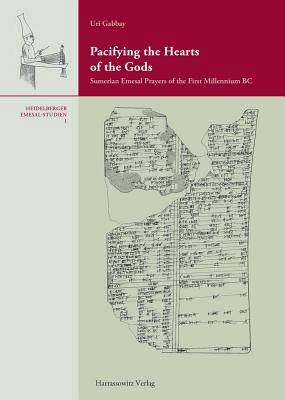
- Afhalen na 1 uur in een winkel met voorraad
- Gratis thuislevering in België vanaf € 30
- Ruim aanbod met 7 miljoen producten
- Afhalen na 1 uur in een winkel met voorraad
- Gratis thuislevering in België vanaf € 30
- Ruim aanbod met 7 miljoen producten
Zoeken
Pacifying the Hearts of the Gods
Sumerian Emesal Prayers of the First Millenium BC
Uri Gabbay
Hardcover | Engels
€ 175,95
+ 351 punten
Omschrijving
Pacifying the Hearts of the Gods investigates the corpus of Emesal prayers, i.e., prayers composed in the Emesal register of the Sumerian language that are known from cuneiform tablets dating from the beginning of the second millennium BC up to the end of the first millennium BC. In the first millennium BC, these prayers, which are usually accompanied by interlinear Akkadian translations, were divided into four main genres, natively called Balag, Ersema, Ersahuga, and Suila. The content of the prayers is usually lamentful, mourning the destruction of various Mesopotamian cities and temples, but it is not restricted to the commemoration of past disasters. The book examines the role of these prayers in the daily, monthly, annual, and noncalendrical cult of the temples of ancient Mesopotamia. It approaches these prayers, especially the Balag and Ersema genres, not only as texts but as part of a larger theological system that includes the ritual context of the prayers, their musical performance, and their cultic performer (the gala/kalu). Focusing on the first millennium BC, the book demonstrates how each element of this system serves the main theological purpose of the prayers: divine pacification. It also discusses the textual transmission of these prayers - most of which were included in the first-millennium BC series of kalutu, "lore of the kalu cultic functionary" - on the basis of changes in the long litanies of gods, epithets, cities, and temples. Special emphasis is given to the scribal context of the prayers.
Specificaties
Betrokkenen
- Auteur(s):
- Uitgeverij:
Inhoud
- Aantal bladzijden:
- 356
- Taal:
- Engels
Eigenschappen
- Productcode (EAN):
- 9783447067485
- Verschijningsdatum:
- 1/05/2014
- Uitvoering:
- Hardcover
- Formaat:
- Genaaid
- Afmetingen:
- 216 mm x 300 mm
- Gewicht:
- 1564 g

Alleen bij Standaard Boekhandel
+ 351 punten op je klantenkaart van Standaard Boekhandel
Beoordelingen
We publiceren alleen reviews die voldoen aan de voorwaarden voor reviews. Bekijk onze voorwaarden voor reviews.








